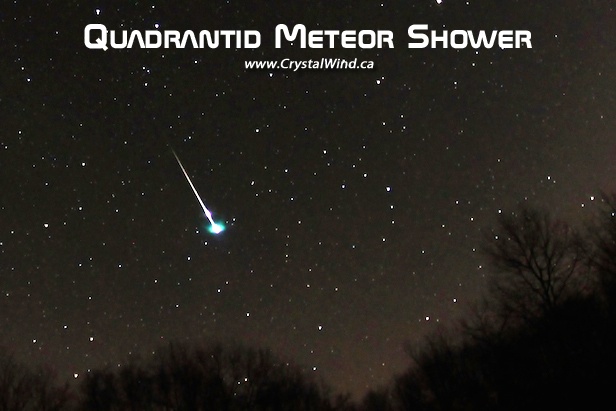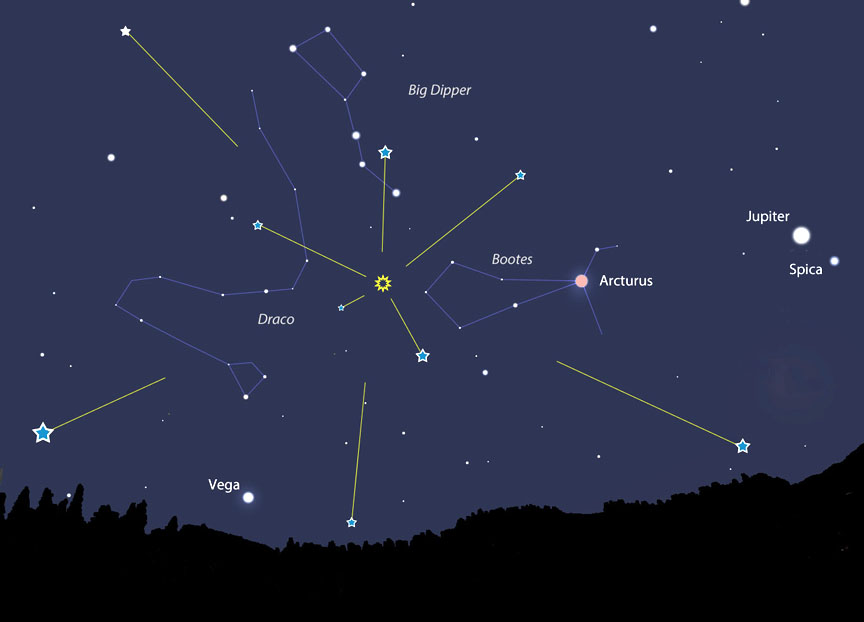


2019 is a decent year to see the annual Quadrantid meteor shower — especially in Europe — during its sharp peak the night of Jan. 3-4.
"A lot of meteor showers last days — the Quadrantids last a few hours," NASA meteor expert Bill Cooke told Space.com. "Europe is favored to view the Quadrantids [because] the peak is around 2 GMT, [9 p.m. on Jan. 3 EST] but viewers in North America might catch a fiew Quadrantids in the ramp-up to the peak."
As many as 100 Quadrantid meteors can be seen some years during the peak when Earth plows through the thickest part of the debris stream, Cooke said, but only if skies are dark enough: Because they're faint, it's easy to miss many of the Quadrantids streaking across the sky. [Amazing Quadrantid Meteor Shower Photos by Stargazers]
According to long-time meteor observer Robert Lunsford of the American Meteor Society, the Quadrantids run from Dec. 22 to Jan. 17, with a sharp peak on Jan. 3. That means that outside the peak time — which occurs during early evening hours for observers in North America — meteor rates may be low.
According to this January skywatching guide released by NASA's Hubble Space Telescope mission team, the 2018 Quadrantids could offer up to 40 meteors per hour overnight on Jan. 3 and 4.
The Quadrantid meteor shower is not as well-known as other meteor showers like the Geminids or Orionids, because the meteors are fainter and easier to miss. However, they can produce fireballs with giant, glowing tails highlighting the meteors' paths across the sky.
The 2019 Quadrantids are expected to peak at 9 p.m. EST (0200 on Jan. 4 GMT), according to Cooke and EarthSky.org, which cited the International Meteor Organization. Since the peak time forecasts occur during daylight hours, the best time for skywatchers to look for the Quadrantids will be overnight on Jan. 3 and 4, with the most meteors visible in the last hour before dawn.
Lunsford forecasts average viewing rates of about 11 sporadic meteors per hour (that's lower than the Hubble telescope guide's forecast) in the last hour before dawn for observers in rural areas.

To find the radiant, you will need to look for the constellation Bootes. The easiest way to find it is to look north for the Big Dipper. Then, follow the "arc" of the Big Dipper's handle across the sky to the red giant star Arcturus, which anchors the bottom of Bootes.
If you happen to catch the shower at an off-peak moment, rates of about 25 meteors per hour are still expected. In the past, Lunsford has recommended keeping Bootes in your field of view, but looking slightly away so that you catch the meteors with the longer tails.
The Quadrantids are thought to be associated with asteroid 2003 EH1, which is likely an extinct comet, Cooke has told Space.com. "It was either a piece of a comet or a comet itself, and then it became extinct," which means that all the ice and other volatiles on the comet have evaporated, he said.
The asteroid has a perihelion (closest approach to the sun) just inside the Earth's orbit, which is pretty far away in celestial terms. Scientists also think that the asteroid may have some connection to the Comet 96P/Machholtz, a comet that orbits the sun once every six years. First observations of the Quadrantids shower appear to be in Europe in the 1820s and 1830s. [How Meteor Showers Work (Infographic)]

Binoculars and telescopes are not useful for meteor showers; your eyes are enough to see the shooting stars streaking overhead. Find a dark sky and give your eyes about 20-30 minutes to adjust.
Dress warmly and face a little away from the radiant in Bootes to catch the longer-streaking meteors.
© 2019 crystalwind.ca. All rights reserved.
© CrystalWind.ca 2024. All content (articles, imagery, fair use) & design protected. Written permission required for copying. All rights reserved.
Join the Conversation Now! Comment Below! ![]()
© 2008-2024 CrystalWind.ca. All rights reserved. Site Creation by CrystalWind.ca.
Web Hosting by Knownhost.com